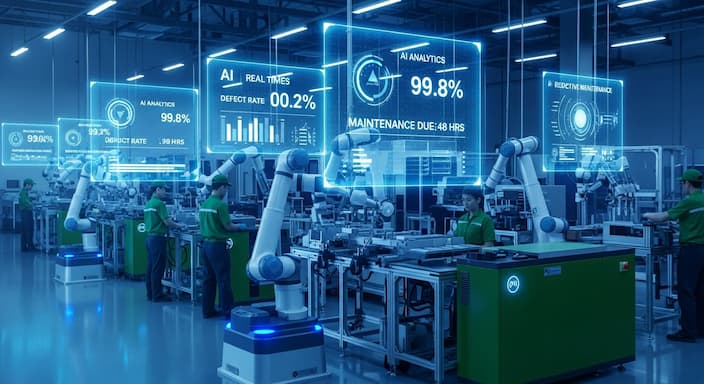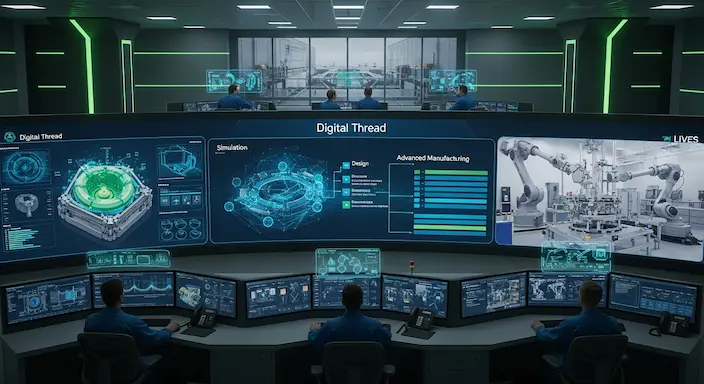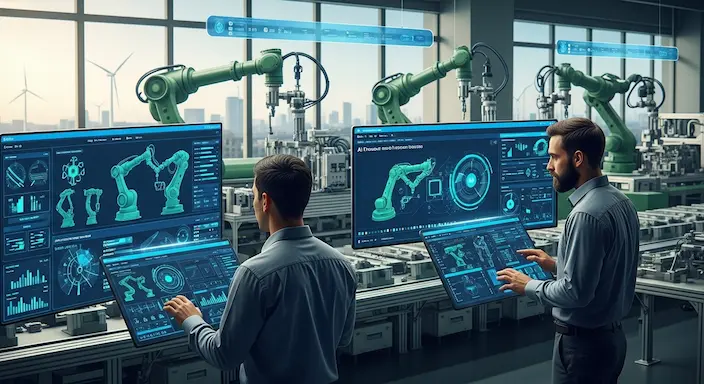Navigating the AI Revolution in Advanced Manufacturing
1. Introduction
The manufacturing sector stands at a pivotal juncture where digital transformation has evolved from aspiration to operational necessity. Artificial intelligence has emerged as a fundamental enabler of this transformation, fundamentally reshaping how companies design, produce, and deliver products across global markets. Unlike previous waves of automation that focused primarily on replacing manual labour with mechanised processes, contemporary AI applications introduce cognitive capabilities that enhance decision-making, predict outcomes, and optimise complex systems in ways previously impossible.
Advanced manufacturing encompasses sophisticated production environments where precision engineering, quality assurance, and operational excellence determine competitive positioning. Industries spanning aerospace, automotive, energy generation, and marine engineering increasingly recognise that AI technologies offer pathways to address longstanding challenges whilst unlocking new operational paradigms.
2. The Present State: Drivers of AI Adoption in Manufacturing
Advanced manufacturing is simultaneously grappling with significant economic challenges and geopolitical shifts. In the first quarter of 2024, approximately two-thirds of respondents surveyed by the National Association of Manufacturers (NAM) identified attracting and retaining skilled workers as their primary challenge. This structural deficit necessitates technological solutions that can augment the existing workforce and automate complex tasks.
Furthermore, persistent geopolitical uncertainties and economic volatility are forcing manufacturers to rethink supply chains. Companies are focusing on building resilience by diversifying sourcing and production away from traditional hubs like China, shifting focus towards Southeast Asian nations such as Vietnam, Malaysia, and India. This need for robustness and adaptability positions AI as a vital element for future-proofing the industry against unforeseen disruptions.

Despite the clear strategic need for AI, its adoption across manufacturing remains nascent compared to knowledge-intensive sectors like marketing and IT. While AI technologies are now widely used in some capacity by 72% of large businesses globally, Generative AI (GenAI) adoption, for example, is more commonly seen in sales and product development functions than in manufacturing or supply chain management.
The current phase of AI integration is therefore characterised by strategic investment in core infrastructure and targeted deployments designed to deliver immediate efficiency gains and address chronic labour shortages. The surge in AI demand, however, requires massive infrastructure buildout, with traditional data centres already struggling to handle AI’s demands. This push has resulted in US companies planning massive data centre buildouts, anticipating over £1 trillion in AI infrastructure spending. Consequently, Big Tech companies are morphing into leading energy innovators to support these intensive AI workloads.
3. Where AI Delivers Operational Improvements in Manufacturing
3.1 Quality Management and Defect Prevention
Quality assurance traditionally consumed substantial resources whilst detecting problems only after occurrence. AI transforms this reactive paradigm into predictive quality management where potential issues are identified and addressed before defective products emerge. Machine learning models trained on historical production data correlate process parameters with quality outcomes, establishing the operational envelope that reliably produces conforming products. When process conditions drift toward boundaries associated with quality degradation, these systems alert operators or automatically adjust parameters to maintain optimal conditions.
This capability proves particularly valuable in advanced manufacturing contexts where material costs are significant and rework proves difficult or impossible. Aerospace composite component production exemplifies such an environment. The carbon fibre layup and curing processes involve precise control of temperature profiles, pressure application, and cure times. Deviations from optimal conditions may not manifest as immediately visible defects but can compromise structural integrity. AI systems monitoring these processes ensure parameters remain within proven bounds whilst learning from each production cycle to refine understanding of acceptable variation.
The economic impact extends beyond reducing scrap rates. Warranty claims, field failures, and reputation damage from quality issues often exceed direct production costs. AI-enabled quality management reduces these downstream consequences whilst simultaneously decreasing inspection labour requirements.
3.2 Supply Chain Optimisation and Inventory Management
Manufacturing competitiveness depends substantially on supply chain efficiency, where excess inventory ties up capital whilst insufficient stock disrupts production schedules. AI applications in this domain analyse demand patterns, supplier performance, logistics constraints, and production requirements to optimise inventory levels and procurement timing. Unlike traditional enterprise resource planning systems relying on fixed rules and safety stock calculations, AI approaches continuously adapt to changing conditions and learn from forecast accuracy.
Demand forecasting represents a fundamental challenge where AI delivers measurable improvements. Manufacturing operations serving multiple markets with seasonal variation, promotional activities, and competitive dynamics face considerable forecasting complexity. Machine learning models incorporate diverse data sources including historical sales, market indicators, weather patterns, and social media sentiment to generate more accurate predictions than conventional statistical methods. Improved forecast accuracy cascades throughout the supply chain, enabling more efficient production scheduling, reduced expediting costs, and better supplier relationships through stable ordering patterns.
Transportation and logistics optimisation similarly benefit from AI capabilities. Route planning for delivery vehicles involves numerous variables including traffic patterns, delivery time windows, vehicle capacity constraints, and fuel costs. AI systems evaluate countless potential solutions, identifying routing strategies that minimise costs whilst meeting customer commitments. For organisations operating their own logistics operations, these optimisations directly improve margins. Companies relying on third-party logistics providers gain negotiating leverage through better understanding of optimal costs and more efficient consolidation of shipments.

3.3 Energy Efficiency and Environmental Performance
Manufacturing facilities represent significant energy consumers, with costs directly impacting competitiveness whilst environmental performance increasingly influences customer preferences and regulatory compliance. AI systems analyse energy consumption patterns across facilities, identifying opportunities for reduction without compromising production output or quality. These systems account for complex interactions between heating, ventilation, and air conditioning systems, process equipment power consumption, and compressed air networks that traditional building management systems cannot optimise holistically.
Real-time load management represents a particularly valuable capability as electricity markets evolve toward dynamic pricing structures reflecting supply and demand fluctuations. AI systems forecast production requirements and coordinate equipment operation to exploit periods of lower energy costs whilst avoiding peak demand charges. This capability grows increasingly important as manufacturing facilities integrate renewable energy sources and battery storage systems, where intelligent management of generation, storage, and consumption determines economic viability.
3.4 Workforce Productivity and Safety Enhancement
Concerns that AI threatens manufacturing employment overlook the technology’s substantial potential for enhancing workforce effectiveness and safety. Collaborative robots guided by AI work alongside human operators, handling repetitive or physically demanding tasks whilst humans focus on judgment-intensive activities requiring problem-solving and adaptability. This collaboration improves productivity without wholesale displacement of experienced workers whose tacit knowledge remains invaluable.
AI-powered training systems accelerate skill development, particularly valuable as manufacturing confronts workforce demographics challenges. These systems provide personalised instruction adapting to individual learning patterns, offering additional practice on challenging concepts whilst advancing through material already mastered. Virtual reality platforms incorporating AI create immersive training environments where workers safely practice procedures on expensive equipment or hazardous processes before undertaking actual operations. This approach reduces training duration whilst improving competency levels, addressing the skills gap that constrains manufacturing capacity expansion.
Safety improvements represent another critical dimension. AI systems monitoring work environments detect unsafe conditions or behaviours, providing real-time warnings that prevent accidents. Computer vision systems identify workers operating equipment without proper protective gear, entering restricted zones, or exhibiting fatigue indicators suggesting increased accident risk. Rather than punitive enforcement, these systems enable proactive intervention through alerts to supervisors or the workers themselves. Manufacturing organisations implementing comprehensive AI safety monitoring report substantial reductions in incident rates alongside reduced insurance costs.
3.5 Product Development and Innovation Acceleration
The integration of AI throughout product development cycles substantially compresses timelines from concept to production. Generative design systems explore vast solution spaces, proposing component configurations that meet specified performance requirements whilst optimising for weight, cost, or manufacturability. These AI-generated designs often incorporate unconventional geometries that human designers might not conceive, leveraging the geometric freedom offered by additive manufacturing to create structures impossible with traditional fabrication methods.
Simulation and testing processes similarly benefit from AI acceleration. Finite element analysis and computational fluid dynamics require substantial computational resources and expert interpretation. AI systems trained on previous simulation results can rapidly evaluate design alternatives, identifying promising candidates for detailed analysis whilst screening out configurations unlikely to meet requirements. This capability proves particularly valuable during early development phases where broad exploration of the design space yields innovation opportunities that narrow, incremental refinement cannot achieve.
4. The Five-Year Horizon: Emerging Trends and Future Developments
4.1 Edge Computing and Distributed Intelligence
The coming five years will witness substantial deployment of AI capabilities at the network edge rather than centralised cloud environments. Manufacturing equipment increasingly incorporates powerful processing capabilities enabling sophisticated AI models to execute locally, analysing sensor data and making decisions within milliseconds rather than the latencies inherent in cloud communication. This architectural shift proves essential for applications requiring real-time response, such as robotic manipulation, process control, and safety systems where network delays prove unacceptable.
Edge deployment offers additional advantages beyond latency reduction. Data sovereignty concerns and bandwidth constraints make transmitting all sensor data to cloud environments impractical for many organisations. Edge AI processes data locally, extracting insights and transmitting only relevant information to enterprise systems. This approach also enhances resilience, as local intelligence continues operating during network disruptions that would cripple cloud-dependent systems.
The integration of 5G wireless networks with edge computing will enable flexible manufacturing configurations previously impossible. Production equipment communicates wirelessly with minimal latency, facilitating rapid reconfiguration of production lines to accommodate product variations or demand shifts. This flexibility proves particularly valuable for manufacturers pursuing mass customisation strategies where product variants proliferate whilst production volumes per configuration remain modest.
4.2 Digital Twins and Simulation-Driven Operations
Digital twin technology—virtual replicas of physical assets, processes, or systems—will achieve widespread deployment as computing costs continue declining and sensor proliferation generates comprehensive operational data. These virtual representations enable manufacturers to simulate operational scenarios, evaluate proposed changes, and optimise performance without risking production disruption. AI models embedded within digital twins continuously update their representations based on actual performance data, ensuring virtual behaviour tracks physical reality even as equipment ages or operating conditions evolve.
Predictive maintenance will evolve beyond simple anomaly detection toward comprehensive remaining useful life estimation. Digital twins incorporating physics-based models and AI learning from fleet-wide data will predict component degradation trajectories with increasing accuracy. This capability enables sophisticated maintenance planning that accounts for production schedules, parts availability, and technician capacity to minimise total lifecycle costs rather than simply preventing failures.
Product development cycles will increasingly leverage digital twins throughout design, testing, and production ramp-up phases. Virtual commissioning of manufacturing systems enables identification and resolution of issues before physical equipment arrives, substantially reducing installation timelines and costs. As products enter service, their digital twins continue providing value through performance monitoring, warranty analysis, and insights informing next-generation development.

4.3 Autonomous Manufacturing Systems
Fully autonomous manufacturing cells capable of operating extended periods without human intervention will transition from research concepts to production reality. These systems combine AI planning and scheduling capabilities with advanced robotics and adaptive control systems that adjust to material variations, tool wear, and environmental conditions. Initial deployments will focus on high-volume production of standardised components where consistent operating conditions enable reliable autonomous operation. However, the technology will gradually expand into more varied production environments as AI systems develop greater adaptability.
The economic case for autonomous manufacturing extends beyond labour cost reduction. Unmanned operations enable efficient utilisation of capital equipment through extended operating hours without shift premiums or fatigue-related quality degradation. Facilities located in regions with extreme climates can operate production areas at temperatures, humidity levels, or atmospheric conditions optimised for processes rather than human comfort. These advantages prove particularly compelling for industries such as semiconductor manufacturing, pharmaceutical production, and precision machining where environmental control significantly impacts yield and quality.
Human roles within increasingly autonomous facilities will emphasise system oversight, exception handling, and continuous improvement rather than direct process operation. This evolution requires different skill profiles emphasising systems thinking, data analysis, and problem-solving over manual dexterity and machine operation. Manufacturing organisations must proactively develop workforce capabilities aligned with this trajectory, investing in training programmes and recruitment strategies that secure required talent.
4.4 Sustainable Manufacturing Through AI Optimisation
Environmental considerations will increasingly drive AI deployment as manufacturers confront carbon reduction commitments, resource scarcity, and regulatory pressures. AI systems will optimise entire value chains for environmental performance alongside traditional cost and quality metrics. This encompasses energy consumption reduction, waste minimisation through process optimisation, and intelligent logistics reducing transportation emissions.
Circular economy principles will benefit substantially from AI capabilities. Product design systems will evaluate end-of-life scenarios alongside traditional performance requirements, facilitating material recovery and remanufacturing. During operational phases, AI monitoring systems will track product condition enabling optimal maintenance timing that extends service life. Upon retirement, AI-guided disassembly systems will efficiently recover valuable materials for reuse, closing material loops that reduce primary resource consumption.
Supply chain transparency enabled by AI analysis of diverse data sources will allow manufacturers and their customers to understand the environmental footprint of products throughout their lifecycles. This visibility enables informed decisions balancing cost, performance, and environmental impact whilst supporting regulatory compliance as governments implement carbon border adjustments and extended producer responsibility requirements.
4.5 Collaborative Ecosystems and Data Sharing
Manufacturing AI capabilities will increasingly depend on collaborative data ecosystems where organisations share insights whilst protecting competitive information. Industry consortia will develop shared AI models trained on aggregated data from multiple companies, creating capabilities no single organisation could develop independently. These collaborative approaches prove particularly valuable for rare failure modes, safety incidents, or quality issues where individual organisations accumulate insufficient data for robust model training.
Standardisation efforts will mature, establishing common data formats, interfaces, and protocols enabling AI systems from different vendors to interoperate seamlessly. Current fragmentation where each equipment manufacturer employs proprietary data structures and communication protocols impedes integration and constrains AI deployment. Industry initiatives supported by standards organisations will establish frameworks reducing integration complexity whilst preserving competitive differentiation in value-adding functionality.
Supply chain integration will deepen as manufacturers and suppliers share AI-generated forecasts, capacity information, and quality data through secure platforms. This transparency enables collaborative planning that optimises entire value chains rather than individual organisations, reducing inventory buffers, shortening lead times, and improving responsiveness to demand fluctuations. Trust frameworks combining contractual arrangements, technological controls, and governance processes will enable this sharing whilst protecting commercially sensitive information.
5. Navigating the Roadblocks to Scaled AI Adoption
Despite the immense potential, the journey to scaled AI adoption in manufacturing is fraught with significant hurdles. Organisations must proactively address these challenges to move past the initial Proof-of-Concept (POC) stage.
Cost and Investment Hurdles: Financial barriers remain the single largest impediment. A significant 65% of executives from the industry and engineering domains cite insufficient budget as a major hurdle, preventing them from moving past the POC phase. Furthermore, 45% of executives express concerns regarding an uncertain return on investment (ROI).
Talent and Workforce Adaptation: The shift demands a profound workforce transformation. There is a scarcity of key talent, specifically data scientists, AI engineers, and product developers, needed to build and manage these complex systems. Organisations must invest strategically in upskilling and reskilling employees to work effectively alongside new robotic systems, addressing workforce concerns and cultural resistance to automation. However, evidence suggests that AI is currently changing jobs by taking over repetitive tasks rather than eliminating them entirely, freeing humans for more complex challenges.
Integration and Infrastructure Deficiencies: Integrating advanced AI technologies with existing, often older, operational technology (OT) systems poses significant difficulty. Nearly half (43%) of industry executives report inadequate technology and tooling infrastructure. Even fundamental networking poses challenges: specialized infrastructure is needed, as metallic surfaces common in factories can limit network bandwidth.
Governance and Trust: As autonomous agents become capable of setting goals and executing complex decisions, establishing clear guardrails and governance is critical. Success depends on building trust, establishing clear governance, and creating new frameworks for human-AI collaboration. Companies must create and enforce policies around workforce protections, balancing productivity gains with job sustainability.
6. Conclusion
Artificial intelligence has evolved from experimental curiosity to operational necessity within advanced manufacturing, delivering measurable improvements in quality, efficiency, and competitiveness. Current deployments demonstrate the technology’s practical value whilst revealing opportunities for expanded application and integration. The substantial challenges, such as data quality, skills availability, integration complexity, prove surmountable with appropriate investment and organisational commitment.
The coming five years will witness continued AI advancement across manufacturing operations, driven by technological maturation, declining implementation costs, and competitive pressures demanding operational excellence. Organisations that strategically deploy AI capabilities whilst developing necessary workforce skills and data infrastructure will strengthen market positions.
Success requires balanced perspective recognising both technology’s potential and its limitations. AI augments rather than replaces human expertise, with greatest value emerging from thoughtful collaboration between algorithmic capabilities and human judgment. This measured approach positions organisations to capture AI’s substantial benefits whilst managing risks and maintaining the operational stability essential for manufacturing success.

Back to the list





